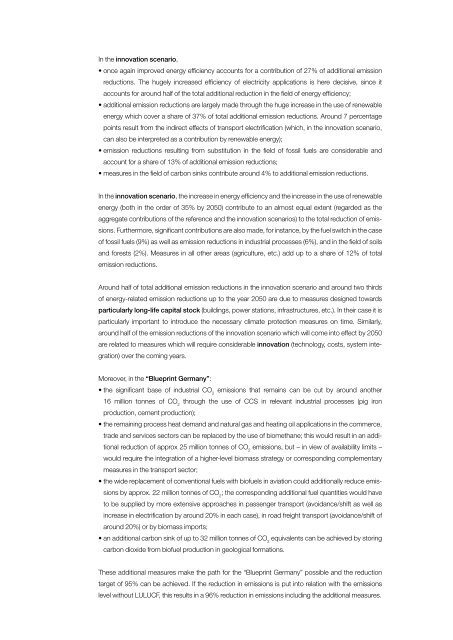Blueprint Germany - Öko-Institut eV
Blueprint Germany - Öko-Institut eV
Blueprint Germany - Öko-Institut eV
Create successful ePaper yourself
Turn your PDF publications into a flip-book with our unique Google optimized e-Paper software.
In the innovation scenario,<br />
• once again improved energy efficiency accounts for a contribution of 27% of additional emission<br />
reductions. The hugely increased efficiency of electricity applications is here decisive, since it<br />
accounts for around half of the total additional reduction in the field of energy efficiency;<br />
• additional emission reductions are largely made through the huge increase in the use of renewable<br />
energy which cover a share of 37% of total additional emission reductions. Around 7 percentage<br />
points result from the indirect effects of transport electrification (which, in the innovation scenario,<br />
can also be interpreted as a contribution by renewable energy);<br />
• emission reductions resulting from substitution in the field of fossil fuels are considerable and<br />
account for a share of 13% of additional emission reductions;<br />
• measures in the field of carbon sinks contribute around 4% to additional emission reductions.<br />
In the innovation scenario, the increase in energy efficiency and the increase in the use of renewable<br />
energy (both in the order of 35% by 2050) contribute to an almost equal extent (regarded as the<br />
aggregate contributions of the reference and the innovation scenarios) to the total reduction of emissions.<br />
Furthermore, significant contributions are also made, for instance, by the fuel switch in the case<br />
of fossil fuels (9%) as well as emission reductions in industrial processes (6%), and in the field of soils<br />
and forests (2%). Measures in all other areas (agriculture, etc.) add up to a share of 12% of total<br />
emission reductions.<br />
Around half of total additional emission reductions in the innovation scenario and around two thirds<br />
of energy-related emission reductions up to the year 2050 are due to measures designed towards<br />
particularly long-life capital stock (buildings, power stations, infrastructures, etc.). In their case it is<br />
particularly important to introduce the necessary climate protection measures on time. Similarly,<br />
around half of the emission reductions of the innovation scenario which will come into effect by 2050<br />
are related to measures which will require considerable innovation (technology, costs, system integration)<br />
over the coming years.<br />
Moreover, in the “<strong>Blueprint</strong> <strong>Germany</strong>”:<br />
• the significant base of industrial CO 2 emissions that remains can be cut by around another<br />
16 million tonnes of CO 2 through the use of CCS in relevant industrial processes (pig iron<br />
production, cement production);<br />
• the remaining process heat demand and natural gas and heating oil applications in the commerce,<br />
trade and services sectors can be replaced by the use of biomethane; this would result in an additional<br />
reduction of approx 25 million tonnes of CO emissions, but – in view of availability limits –<br />
2<br />
would require the integration of a higher-level biomass strategy or corresponding complementary<br />
measures in the transport sector;<br />
• the wide replacement of conventional fuels with biofuels in aviation could additionally reduce emissions<br />
by approx. 22 million tonnes of CO ; the corresponding additional fuel quantities would have<br />
2<br />
to be supplied by more extensive approaches in passenger transport (avoidance/shift as well as<br />
increase in electrification by around 20% in each case), in road freight transport (avoidance/shift of<br />
around 20%) or by biomass imports;<br />
• an additional carbon sink of up to 32 million tonnes of CO equivalents can be achieved by storing<br />
2<br />
carbon dioxide from biofuel production in geological formations.<br />
These additional measures make the path for the “<strong>Blueprint</strong> <strong>Germany</strong>” possible and the reduction<br />
target of 95% can be achieved. If the reduction in emissions is put into relation with the emissions<br />
level without LULUCF, this results in a 96% reduction in emissions including the additional measures.

















